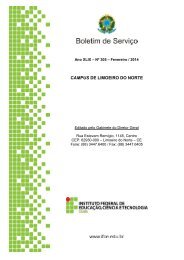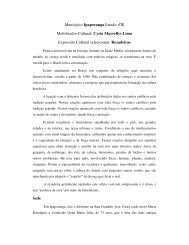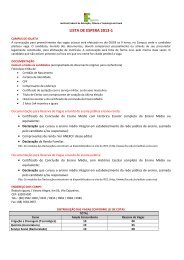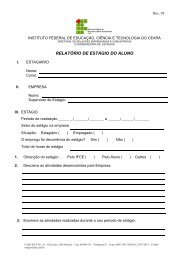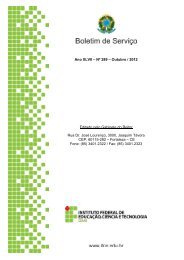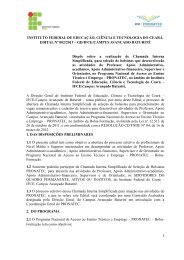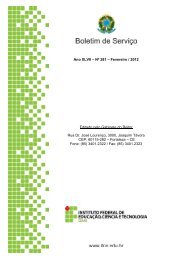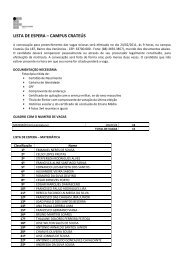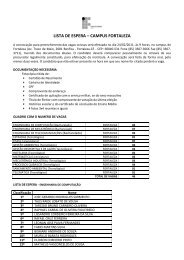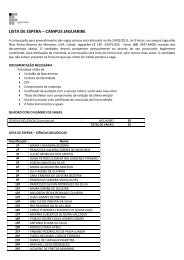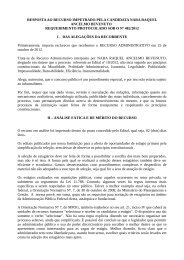MATLAB 1) Introdução 2) Geração de Sinais Amostrados
MATLAB 1) Introdução 2) Geração de Sinais Amostrados
MATLAB 1) Introdução 2) Geração de Sinais Amostrados
You also want an ePaper? Increase the reach of your titles
YUMPU automatically turns print PDFs into web optimized ePapers that Google loves.
Tópicos em Processamento <strong>de</strong> <strong>Sinais</strong><br />
Departamento <strong>de</strong> Engenharia Elétrica<br />
Faculda<strong>de</strong> <strong>de</strong> Tecnologia<br />
Universida<strong>de</strong> <strong>de</strong> Brasília<br />
is an N-D array, FILTER operates along the first non-singleton<br />
dimension.<br />
[Y,Zf] = FILTER(B,A,X,Zi) gives access to initial and final<br />
conditions, Zi and Zf, of the <strong>de</strong>lays. Zi is a vector of length<br />
MAX(LENGTH(A),LENGTH(B))-1 or an array of such vectors, one for<br />
each column of X.<br />
FILTER(B,A,X,[],DIM) or FILTER(B,A,X,Zi,DIM) operates along the<br />
dimension DIM.<br />
See also FILTER2, FILTFILT (in the Signal Processing Toolbox).<br />
Assim, a função tem, em geral, três argumentos: os vetores A e B, correspon<strong>de</strong>ntes aos<br />
coeficientes dos filtros, e o vetor <strong>de</strong> entrada. O resultado da função é o vetor <strong>de</strong> saída.<br />
Antes <strong>de</strong> fazermos um exemplo com a função filter, vamos observar que o Matlab possui<br />
várias ferramentas que permitem a <strong>de</strong>terminação dos coeficientes A e B. Um exemplo é a função<br />
butter. Observe o help <strong>de</strong>sta função:<br />
BUTTER Butterworth digital and analog filter <strong>de</strong>sign.<br />
[B,A] = BUTTER(N,Wn) <strong>de</strong>signs an N'th or<strong>de</strong>r lowpass digital<br />
Butterworth filter and returns the filter coefficients in length<br />
N+1 vectors B and A. The cut-off frequency Wn must be<br />
0.0 < Wn < 1.0, with 1.0 corresponding to half the sample rate.<br />
If Wn is a two-element vector, Wn = [W1 W2], BUTTER returns an<br />
or<strong>de</strong>r 2N bandpass filter with passband W1 < W < W2.<br />
[B,A] = BUTTER(N,Wn,'high') <strong>de</strong>signs a highpass filter.<br />
[B,A] = BUTTER(N,Wn,'stop') is a bandstop filter if Wn = [W1 W2].<br />
When used with three left-hand arguments, as in<br />
[Z,P,K] = BUTTER(...), the zeros and poles are returned in<br />
length N column vectors Z and P, and the gain in scalar K.<br />
When used with four left-hand arguments, as in<br />
[A,B,C,D] = BUTTER(...), state-space matrices are returned.<br />
BUTTER(N,Wn,'s'), BUTTER(N,Wn,'high','s') and BUTTER(N,Wn,'stop','s')<br />
<strong>de</strong>sign analog Butterworth filters. In this case, Wn can be bigger<br />
than 1.0.<br />
See also BUTTORD, BESSELF, CHEBY1, CHEBY2, ELLIP, FREQZ, FILTER.<br />
19



